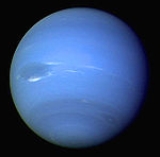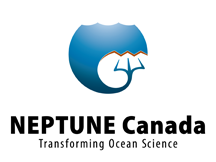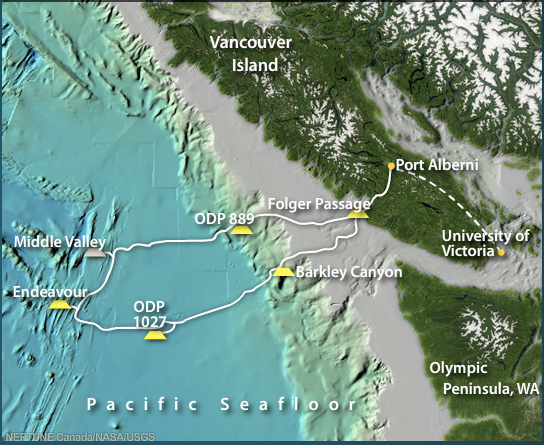
NEPTUNE
Encyclopedia

Internet
The Internet is a global system of interconnected computer networks that use the standard Internet protocol suite to serve billions of users worldwide...
. Since December 2009, it has allowed people to "surf" the seafloor while ocean scientists run deep-water experiments from labs and universities around the world. Along with its sister project, VENUS
VENUS
VENUS - http://venus.uvic.ca - is a cabled sea floor observatory operated out of the University of Victoria, British Columbia, Canada. The VENUS cabled ocean observatory is designed to provide new ways of studying the ocean...
, NEPTUNE offers a unique approach to ocean science. Traditionally, ocean scientists have relied on infrequent ship cruises or space-based satellites to carry out their research, while the NEPTUNE project uses a remotely operated crawler.
Overview

Juan de Fuca Plate
The Juan de Fuca Plate, named after the explorer of the same name, is a tectonic plate, generated from the Juan de Fuca Ridge, and subducting under the northerly portion of the western side of the North American Plate at the Cascadia subduction zone...
—smallest of Earth’s 12 tectonic plates
Plate tectonics
Plate tectonics is a scientific theory that describes the large scale motions of Earth's lithosphere...
. Its small size and close proximity to the coast gives NEPTUNE Canada a unique opportunity to observe tectonic processes. NEPTUNE Canada is built to provide continuous observations for 25 years. The time-series data gathered will allow scientists to study long-term changes over the life of the project. Instruments comprising the undersea observatory will operate at depths ranging from 17 to 2,660 m. Hundreds of instruments have been connected to the Internet by way of shielded cable
Shielded cable
A shielded or screened cable is an electrical cable of one or more insulated conductors enclosed by a common conductive layer. The shield may be composed of braided strands of copper , a non-braided spiral winding of copper tape, or a layer of conducting polymer. Usually, this shield is covered...
s carrying both power and fibre-optic communication
Fiber-optic communication
Fiber-optic communication is a method of transmitting information from one place to another by sending pulses of light through an optical fiber. The light forms an electromagnetic carrier wave that is modulated to carry information...
lines. A database will archive and provide networked
Network model
The network model is a database model conceived as a flexible way of representing objects and their relationships. Its distinguishing feature is that the schema, viewed as a graph in which object types are nodes and relationship types are arcs, is not restricted to being a hierarchy or lattice.The...
access to all archived data. Taking advantage of this platform, scientists collaborating with NEPTUNE are expected conduct thousands of unique experiments over the life of the project.
Status
- In 2007, NEPTUNE Canada laid approximately 800 km of power transmission and fibre optic communication cables over the northern part of the Juan de Fuca tectonic plateJuan de Fuca PlateThe Juan de Fuca Plate, named after the explorer of the same name, is a tectonic plate, generated from the Juan de Fuca Ridge, and subducting under the northerly portion of the western side of the North American Plate at the Cascadia subduction zone...
off the west coast of Vancouver IslandVancouver IslandVancouver Island is a large island in British Columbia, Canada. It is one of several North American locations named after George Vancouver, the British Royal Navy officer who explored the Pacific Northwest coast of North America between 1791 and 1794...
in British ColumbiaBritish ColumbiaBritish Columbia is the westernmost of Canada's provinces and is known for its natural beauty, as reflected in its Latin motto, Splendor sine occasu . Its name was chosen by Queen Victoria in 1858...
. The University of VictoriaUniversity of VictoriaThe University of Victoria, often referred to as UVic, is the second oldest public research university in British Columbia, Canada. It is a research intensive university located in Saanich and Oak Bay, about northeast of downtown Victoria. The University's annual enrollment is about 20,000 students...
hosts both the NEPTUNE Canada and VENUSVENUSVENUS - http://venus.uvic.ca - is a cabled sea floor observatory operated out of the University of Victoria, British Columbia, Canada. The VENUS cabled ocean observatory is designed to provide new ways of studying the ocean...
projects along with the Data Management and Archiving System that is responsible for all data processing, from data acquisition to archiving to providing near real-time web access.
- The NEPTUNE project was selected as one of the five most significant science projects of the year in 2008 from The EconomistThe EconomistThe Economist is an English-language weekly news and international affairs publication owned by The Economist Newspaper Ltd. and edited in offices in the City of Westminster, London, England. Continuous publication began under founder James Wilson in September 1843...
.
- In June 2008, the NEPTUNE project received and successfully tested the world's first “Internet-operated deep sea crawler,” created by a team of ocean scientists at Bremen's Jacobs University, will help researchers measure conditions such as temperature, salinity, methane content and sediment characteristics at the seafloor. The crawler “crawls” on dual tractor treads, which allow a full range of forward, backward and turning movement. Including its titanium frame, drive motors, sealed electronics chambers, wiring, lights, HD video camera, and sensors, the unit's out-of-water weight is 275 kg. With syntactic foam floatation blocks attached, this is reduced to an in-water weight of 40 kg. One unique feature is its control interface, which plugs directly into the Web. Interested people will be able to tune in to a live sea floor crawl on the NEPTUNE website.
- Late September 2008 NEPTUNE Canada's first fully instrumented instrument platform was deployed by ROPOSROPOSROPOS is an ROV used primarily for scientific research. It was originally build in Vancouver by International Submarine Engineering and purchased by the Canadian federal government. This government program also operated the Pisces IV manned submersible...
from the Canadian Coast Guard Ship John P TullyCCGS John P. TullyThe CCGS John P. Tully is a offshore oceanographic science vessel in the Canadian Coast GuardShe was built by Bel-Air Shipyards in Vancouver, British Columbia, in 1985....
in Saanich Inlet and connected to the VENUSVENUSVENUS - http://venus.uvic.ca - is a cabled sea floor observatory operated out of the University of Victoria, British Columbia, Canada. The VENUS cabled ocean observatory is designed to provide new ways of studying the ocean...
Saanich Inlet node. This platform was recovered in early 2009 and reconfigured for deployment at Endeavour Ridge during the summer of 2010.
- A similar observatory will be installed off the west coast of the states of Washington and OregonOregonOregon is a state in the Pacific Northwest region of the United States. It is located on the Pacific coast, with Washington to the north, California to the south, Nevada on the southeast and Idaho to the east. The Columbia and Snake rivers delineate much of Oregon's northern and eastern...
. The University of WashingtonUniversity of WashingtonUniversity of Washington is a public research university, founded in 1861 in Seattle, Washington, United States. The UW is the largest university in the Northwest and the oldest public university on the West Coast. The university has three campuses, with its largest campus in the University...
will lead the Regional Scale Nodes component of the NSFNational Science FoundationThe National Science Foundation is a United States government agency that supports fundamental research and education in all the non-medical fields of science and engineering. Its medical counterpart is the National Institutes of Health...
's Ocean Observatories InitiativeOcean Observatories InitiativeThe Ocean Observatories Initiative is an NSF Division of Ocean Sciences program that focuses the science, technology, education and outreach of an emerging network of science driven ocean observing systems...
.
- July–October 2009, the main science nodes were installed along with 11 instrument platforms and over 60 scientific instruments.
- 8 December 2009, NEPTUNE Canada's official operational launch was celebrated with a Go-live Event.
- March 2010, Robert Gagosian, president and chief executive officer of the Consortium for Ocean Leadership in Washington, D.C., and Martin Taylor, president and chief executive officer of Ocean Networks Canada (umbrella organization for both NEPTUNE Canada and VENUSVENUSVENUS - http://venus.uvic.ca - is a cabled sea floor observatory operated out of the University of Victoria, British Columbia, Canada. The VENUS cabled ocean observatory is designed to provide new ways of studying the ocean...
), signed a memorandum of understanding pledging to work closely together as they manage and operate ocean observing systems.
- May 2010, instrument platforms were refurbished and new instruments installed during an installation and maintenance cruise aboard the Canadian Coast Guard Ship John P TullyCCGS John P. TullyThe CCGS John P. Tully is a offshore oceanographic science vessel in the Canadian Coast GuardShe was built by Bel-Air Shipyards in Vancouver, British Columbia, in 1985....
.
- Fall 2010, new cables were laid and instruments installed as NEPTUNE Canada extended its network to the Endeavour Hydrothermal VentsEndeavour Hydrothermal VentsThe Endeavour Hydrothermal Vents are a group of hydrothermal vents in the northeastern Pacific Ocean, located southwest of Vancouver Island, British Columbia, Canada...
. These installations were accomplished with the help of the crews of the RV Thomas G. Thompson, the Canadian Coast Guard Ship John P TullyCCGS John P. TullyThe CCGS John P. Tully is a offshore oceanographic science vessel in the Canadian Coast GuardShe was built by Bel-Air Shipyards in Vancouver, British Columbia, in 1985....
and CSSF/ROPOSROPOSROPOS is an ROV used primarily for scientific research. It was originally build in Vancouver by International Submarine Engineering and purchased by the Canadian federal government. This government program also operated the Pisces IV manned submersible...
.
External links
- NEPTUNE Canada official website
- NEPTUNE Canada Wiki
- Ocean Networks Canada
- VENUS
- Canadian Scientific Submersible Facility (ROPOS)

